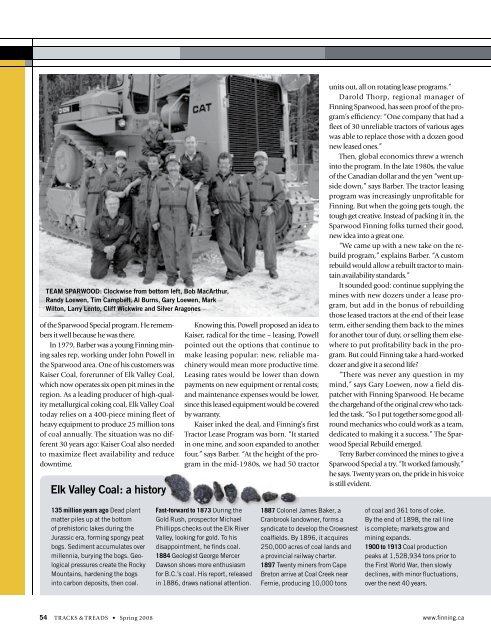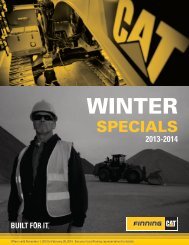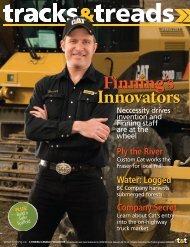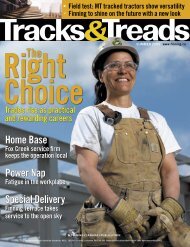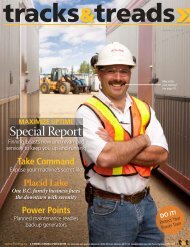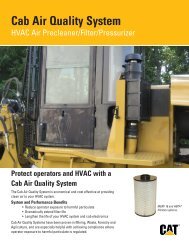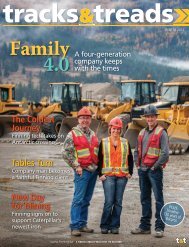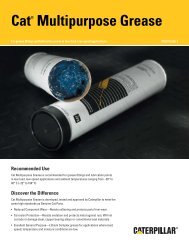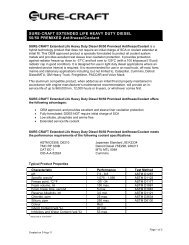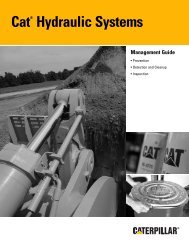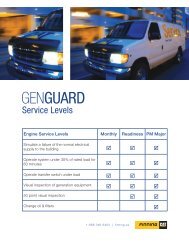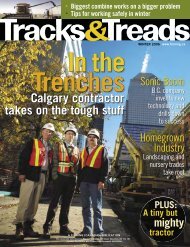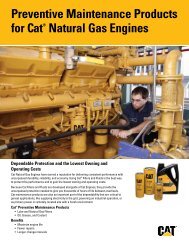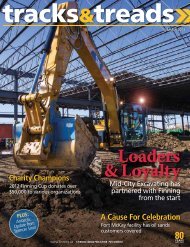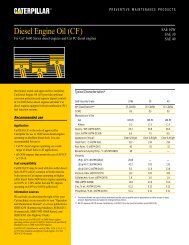Everyday Heroes: Meet Finning's service ... - Finning Canada
Everyday Heroes: Meet Finning's service ... - Finning Canada
Everyday Heroes: Meet Finning's service ... - Finning Canada
Create successful ePaper yourself
Turn your PDF publications into a flip-book with our unique Google optimized e-Paper software.
TEAM SPARWOOD: Clockwise from bottom left, Bob MacArthur,Randy Loewen, Tim Campbell, Al Burns, Gary Loewen, MarkWilton, Larry Lento, Cliff Wickwire and Silver Aragonesof the Sparwood Special program. He remembersit well because he was there.In 1979, Barber was a young <strong>Finning</strong> miningsales rep, working under John Powell inthe Sparwood area. One of his customers wasKaiser Coal, forerunner of Elk Valley Coal,which now operates six open pit mines in theregion. As a leading producer of high-qualitymetallurgical coking coal, Elk Valley Coaltoday relies on a 400-piece mining fleet ofheavy equipment to produce 25 million tonsof coal annually. The situation was no different30 years ago: Kaiser Coal also neededto maximize fleet availability and reducedowntime.Elk Valley Coal: a historyKnowing this, Powell proposed an idea toKaiser, radical for the time – leasing. Powellpointed out the options that continue tomake leasing popular: new, reliable machinerywould mean more productive time.Leasing rates would be lower than downpayments on new equipment or rental costs;and maintenance expenses would be lower,since this leased equipment would be coveredby warranty.Kaiser inked the deal, and <strong>Finning</strong>’s firstTractor Lease Program was born. “It startedin one mine, and soon expanded to anotherfour,” says Barber. “At the height of the programin the mid-1980s, we had 50 tractorunits out, all on rotating lease programs.”Darold Thorp, regional manager of<strong>Finning</strong> Sparwood, has seen proof of the program’sefficiency: “One company that had afleet of 30 unreliable tractors of various ageswas able to replace those with a dozen goodnew leased ones.”Then, global economics threw a wrenchinto the program. In the late 1980s, the valueof the Canadian dollar and the yen “went upsidedown,” says Barber. The tractor leasingprogram was increasingly unprofitable for<strong>Finning</strong>. But when the going gets tough, thetough get creative. Instead of packing it in, theSparwood <strong>Finning</strong> folks turned their good,new idea into a great one.“We came up with a new take on the rebuildprogram,” explains Barber. “A customrebuild would allow a rebuilt tractor to maintainavailability standards.”It sounded good: continue supplying themines with new dozers under a lease program,but add in the bonus of rebuildingthose leased tractors at the end of their leaseterm, either sending them back to the minesfor another tour of duty, or selling them elsewhereto put profitability back in the program.But could <strong>Finning</strong> take a hard-workeddozer and give it a second life?“There was never any question in mymind,” says Gary Loewen, now a field dispatcherwith <strong>Finning</strong> Sparwood. He becamethe chargehand of the original crew who tackledthe task. “So I put together some good allroundmechanics who could work as a team,dedicated to making it a success.” The SparwoodSpecial Rebuild emerged.Terry Barber convinced the mines to give aSparwood Special a try. “It worked famously,”he says. Twenty years on, the pride in his voiceis still evident.135 million years ago Dead plantmatter piles up at the bottomof prehistoric lakes during theJurassic era, forming spongy peatbogs. Sediment accumulates overmillennia, burying the bogs. Geologicalpressures create the RockyMountains, hardening the bogsinto carbon deposits, then coal.Fast-forward to 1873 During theGold Rush, prospector MichaelPhillipps checks out the Elk RiverValley, looking for gold. To hisdisappointment, he finds coal.1884 Geologist George MercerDawson shows more enthusiasmfor B.C.’s coal. His report, releasedin 1886, draws national attention.1887 Colonel James Baker, aCranbrook landowner, forms asyndicate to develop the Crowsnestcoalfields. By 1896, it acquires250,000 acres of coal lands anda provincial railway charter.1897 Twenty miners from CapeBreton arrive at Coal Creek nearFernie, producing 10,000 tonsof coal and 361 tons of coke.By the end of 1898, the rail lineis complete; markets grow andmining expands.1900 to 1913 Coal productionpeaks at 1,528,934 tons prior tothe First World War, then slowlydeclines, with minor fluctuations,over the next 40 years.54 TRACKS & TREADS • Spring 2008 www.finning.ca


